Basic Concepts and Ideology of International Marketing
VerifiedAdded on 2022/09/11
|13
|2903
|12
AI Summary
Contribute Materials
Your contribution can guide someone’s learning journey. Share your
documents today.
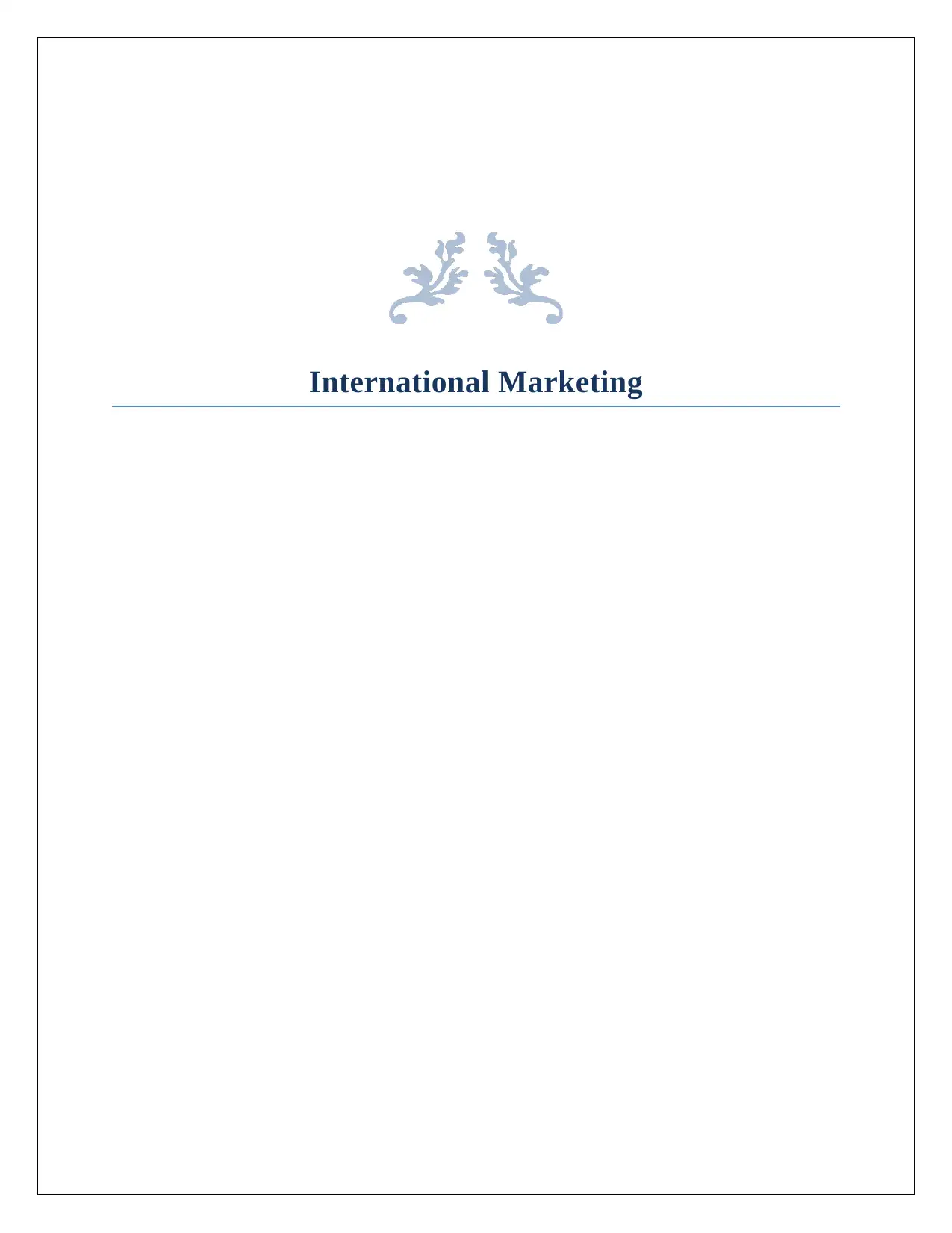
International Marketing
Secure Best Marks with AI Grader
Need help grading? Try our AI Grader for instant feedback on your assignments.
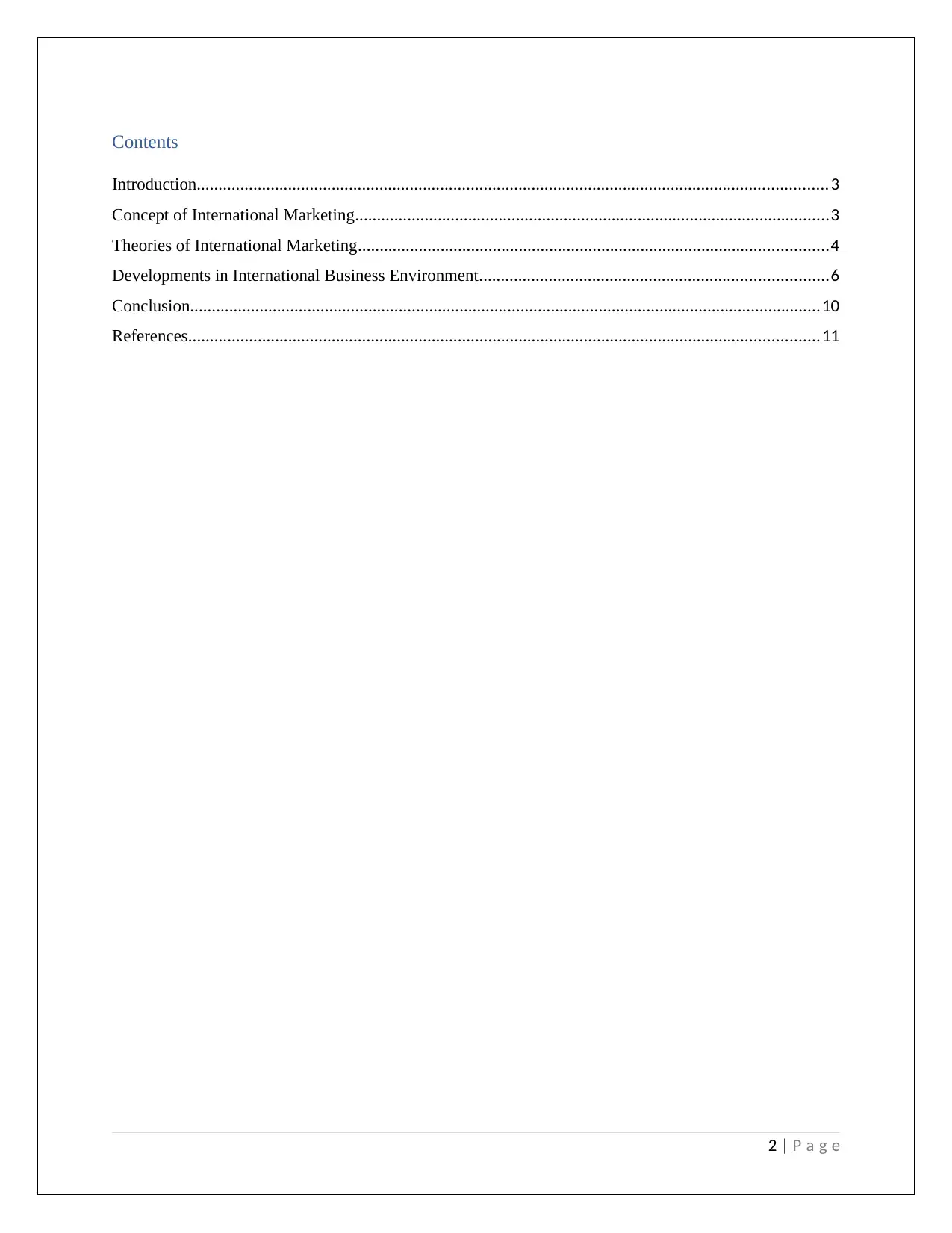
Contents
Introduction.................................................................................................................................................3
Concept of International Marketing.............................................................................................................3
Theories of International Marketing............................................................................................................4
Developments in International Business Environment................................................................................6
Conclusion.................................................................................................................................................10
References.................................................................................................................................................11
2 | P a g e
Introduction.................................................................................................................................................3
Concept of International Marketing.............................................................................................................3
Theories of International Marketing............................................................................................................4
Developments in International Business Environment................................................................................6
Conclusion.................................................................................................................................................10
References.................................................................................................................................................11
2 | P a g e
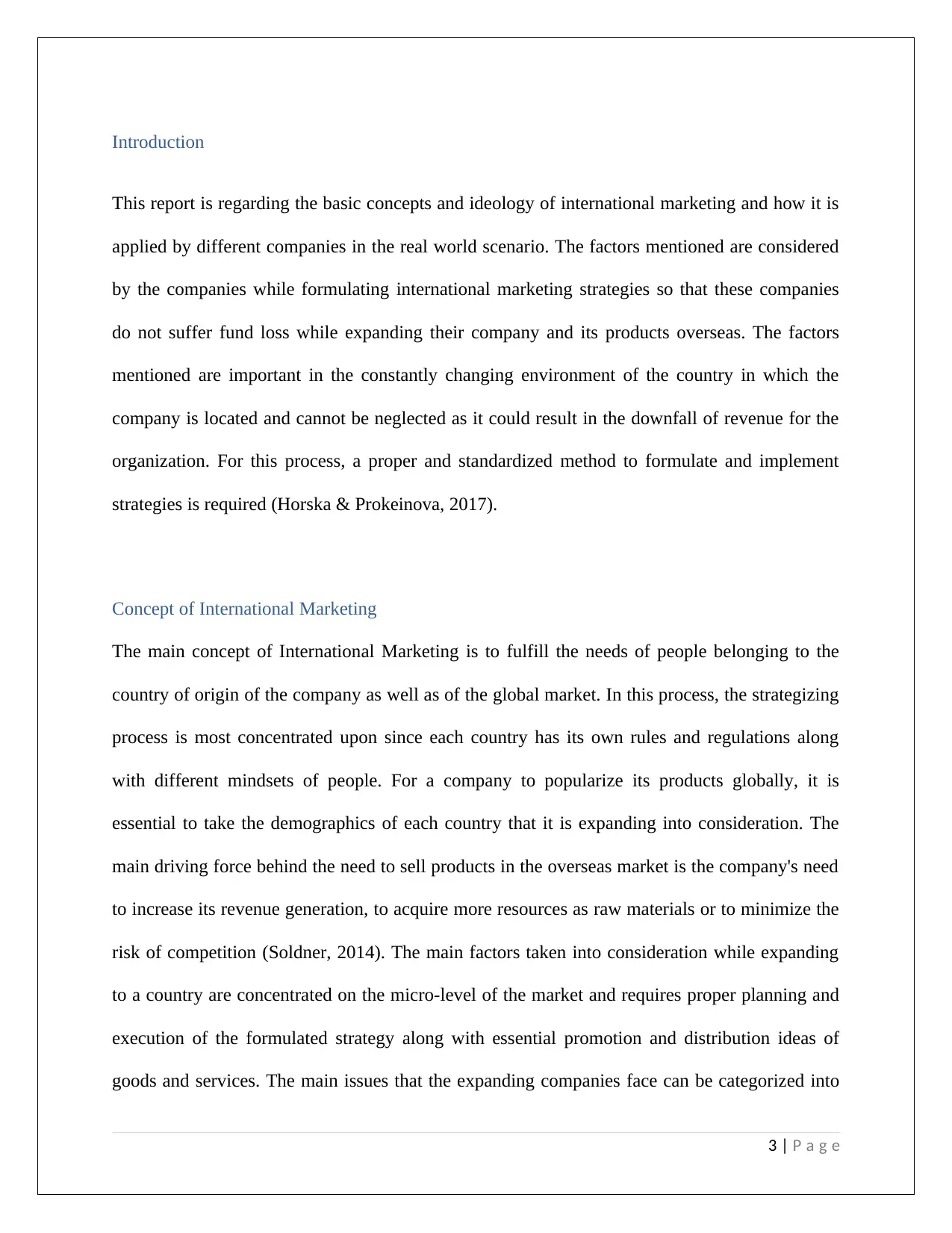
Introduction
This report is regarding the basic concepts and ideology of international marketing and how it is
applied by different companies in the real world scenario. The factors mentioned are considered
by the companies while formulating international marketing strategies so that these companies
do not suffer fund loss while expanding their company and its products overseas. The factors
mentioned are important in the constantly changing environment of the country in which the
company is located and cannot be neglected as it could result in the downfall of revenue for the
organization. For this process, a proper and standardized method to formulate and implement
strategies is required (Horska & Prokeinova, 2017).
Concept of International Marketing
The main concept of International Marketing is to fulfill the needs of people belonging to the
country of origin of the company as well as of the global market. In this process, the strategizing
process is most concentrated upon since each country has its own rules and regulations along
with different mindsets of people. For a company to popularize its products globally, it is
essential to take the demographics of each country that it is expanding into consideration. The
main driving force behind the need to sell products in the overseas market is the company's need
to increase its revenue generation, to acquire more resources as raw materials or to minimize the
risk of competition (Soldner, 2014). The main factors taken into consideration while expanding
to a country are concentrated on the micro-level of the market and requires proper planning and
execution of the formulated strategy along with essential promotion and distribution ideas of
goods and services. The main issues that the expanding companies face can be categorized into
3 | P a g e
This report is regarding the basic concepts and ideology of international marketing and how it is
applied by different companies in the real world scenario. The factors mentioned are considered
by the companies while formulating international marketing strategies so that these companies
do not suffer fund loss while expanding their company and its products overseas. The factors
mentioned are important in the constantly changing environment of the country in which the
company is located and cannot be neglected as it could result in the downfall of revenue for the
organization. For this process, a proper and standardized method to formulate and implement
strategies is required (Horska & Prokeinova, 2017).
Concept of International Marketing
The main concept of International Marketing is to fulfill the needs of people belonging to the
country of origin of the company as well as of the global market. In this process, the strategizing
process is most concentrated upon since each country has its own rules and regulations along
with different mindsets of people. For a company to popularize its products globally, it is
essential to take the demographics of each country that it is expanding into consideration. The
main driving force behind the need to sell products in the overseas market is the company's need
to increase its revenue generation, to acquire more resources as raw materials or to minimize the
risk of competition (Soldner, 2014). The main factors taken into consideration while expanding
to a country are concentrated on the micro-level of the market and requires proper planning and
execution of the formulated strategy along with essential promotion and distribution ideas of
goods and services. The main issues that the expanding companies face can be categorized into
3 | P a g e
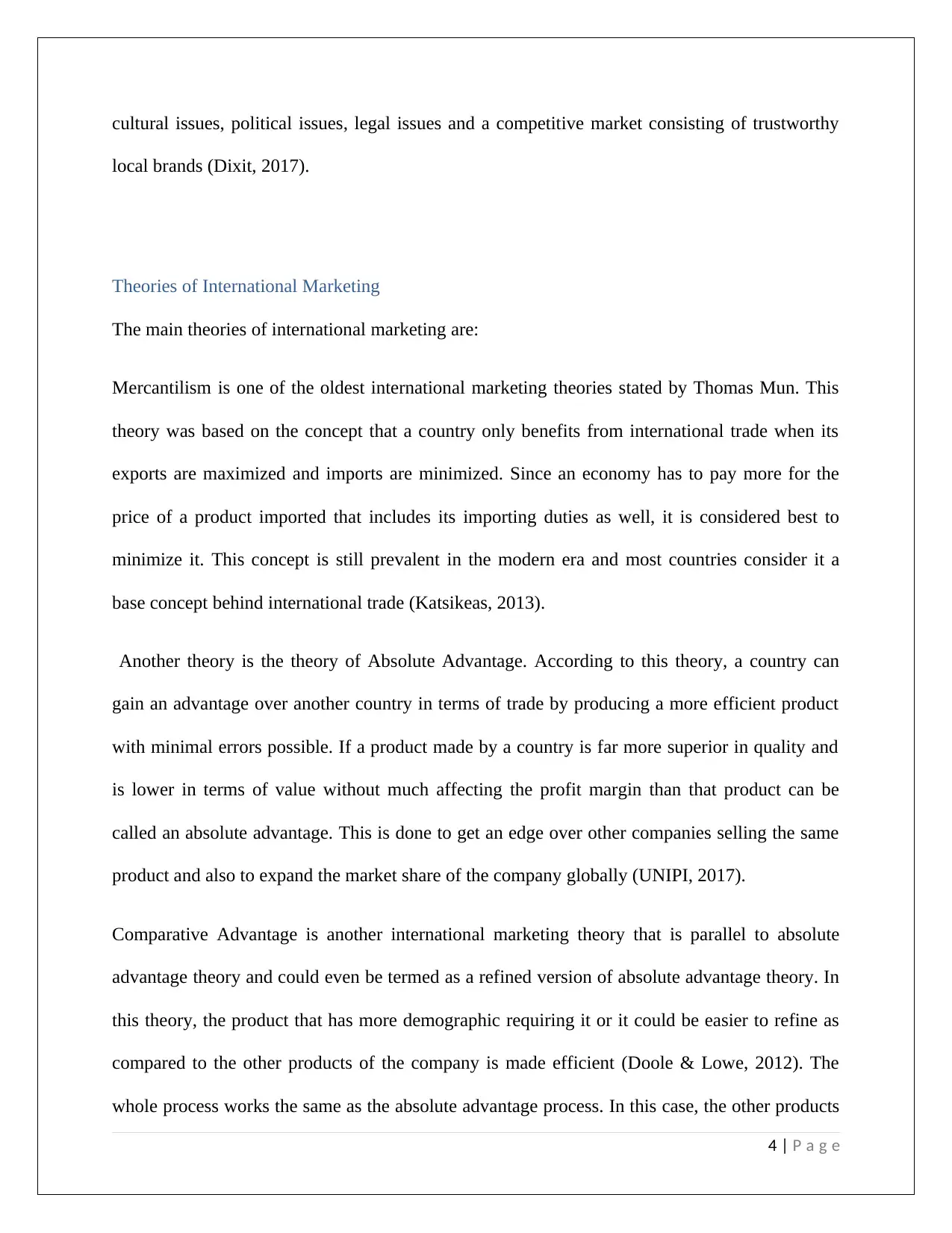
cultural issues, political issues, legal issues and a competitive market consisting of trustworthy
local brands (Dixit, 2017).
Theories of International Marketing
The main theories of international marketing are:
Mercantilism is one of the oldest international marketing theories stated by Thomas Mun. This
theory was based on the concept that a country only benefits from international trade when its
exports are maximized and imports are minimized. Since an economy has to pay more for the
price of a product imported that includes its importing duties as well, it is considered best to
minimize it. This concept is still prevalent in the modern era and most countries consider it a
base concept behind international trade (Katsikeas, 2013).
Another theory is the theory of Absolute Advantage. According to this theory, a country can
gain an advantage over another country in terms of trade by producing a more efficient product
with minimal errors possible. If a product made by a country is far more superior in quality and
is lower in terms of value without much affecting the profit margin than that product can be
called an absolute advantage. This is done to get an edge over other companies selling the same
product and also to expand the market share of the company globally (UNIPI, 2017).
Comparative Advantage is another international marketing theory that is parallel to absolute
advantage theory and could even be termed as a refined version of absolute advantage theory. In
this theory, the product that has more demographic requiring it or it could be easier to refine as
compared to the other products of the company is made efficient (Doole & Lowe, 2012). The
whole process works the same as the absolute advantage process. In this case, the other products
4 | P a g e
local brands (Dixit, 2017).
Theories of International Marketing
The main theories of international marketing are:
Mercantilism is one of the oldest international marketing theories stated by Thomas Mun. This
theory was based on the concept that a country only benefits from international trade when its
exports are maximized and imports are minimized. Since an economy has to pay more for the
price of a product imported that includes its importing duties as well, it is considered best to
minimize it. This concept is still prevalent in the modern era and most countries consider it a
base concept behind international trade (Katsikeas, 2013).
Another theory is the theory of Absolute Advantage. According to this theory, a country can
gain an advantage over another country in terms of trade by producing a more efficient product
with minimal errors possible. If a product made by a country is far more superior in quality and
is lower in terms of value without much affecting the profit margin than that product can be
called an absolute advantage. This is done to get an edge over other companies selling the same
product and also to expand the market share of the company globally (UNIPI, 2017).
Comparative Advantage is another international marketing theory that is parallel to absolute
advantage theory and could even be termed as a refined version of absolute advantage theory. In
this theory, the product that has more demographic requiring it or it could be easier to refine as
compared to the other products of the company is made efficient (Doole & Lowe, 2012). The
whole process works the same as the absolute advantage process. In this case, the other products
4 | P a g e
Secure Best Marks with AI Grader
Need help grading? Try our AI Grader for instant feedback on your assignments.
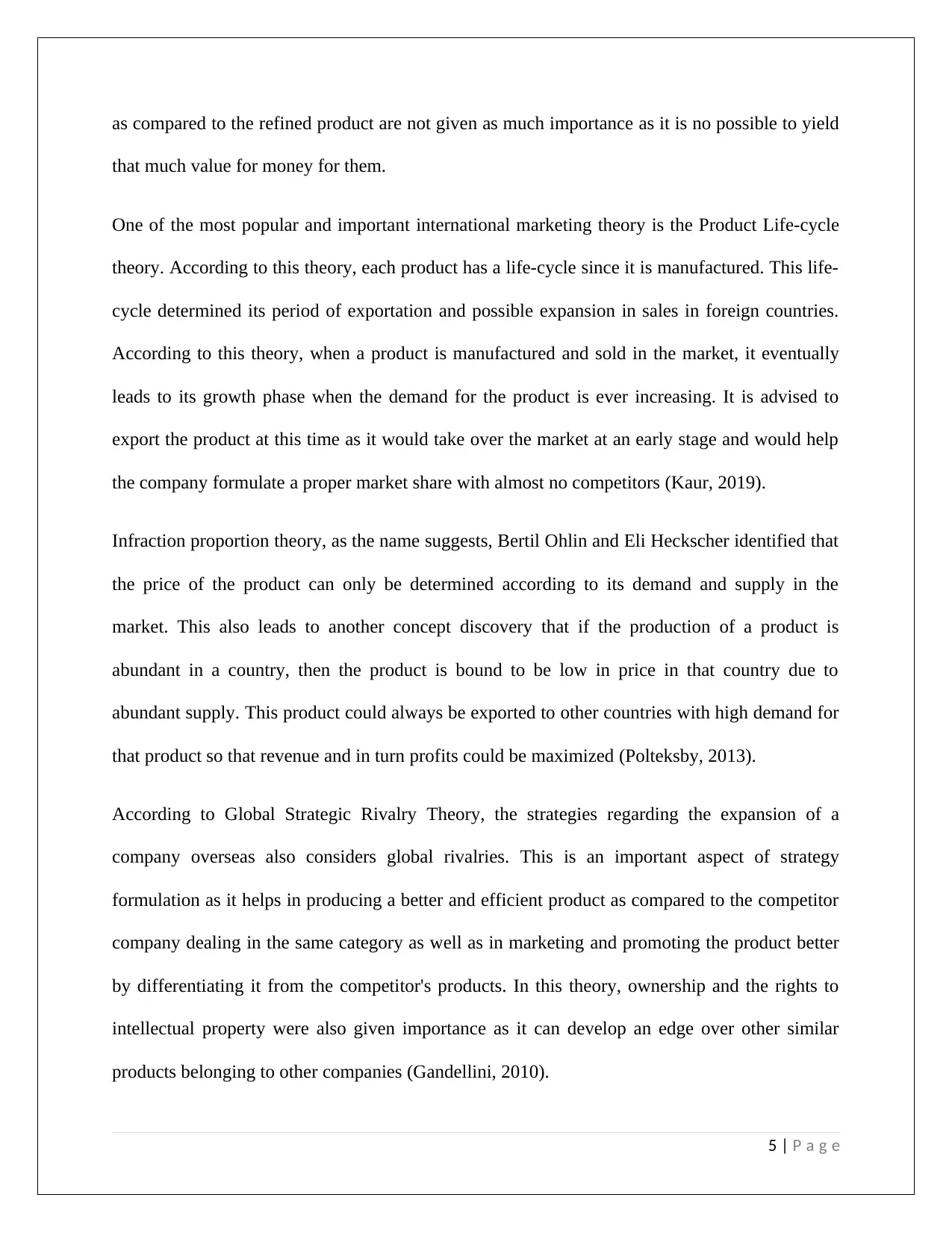
as compared to the refined product are not given as much importance as it is no possible to yield
that much value for money for them.
One of the most popular and important international marketing theory is the Product Life-cycle
theory. According to this theory, each product has a life-cycle since it is manufactured. This life-
cycle determined its period of exportation and possible expansion in sales in foreign countries.
According to this theory, when a product is manufactured and sold in the market, it eventually
leads to its growth phase when the demand for the product is ever increasing. It is advised to
export the product at this time as it would take over the market at an early stage and would help
the company formulate a proper market share with almost no competitors (Kaur, 2019).
Infraction proportion theory, as the name suggests, Bertil Ohlin and Eli Heckscher identified that
the price of the product can only be determined according to its demand and supply in the
market. This also leads to another concept discovery that if the production of a product is
abundant in a country, then the product is bound to be low in price in that country due to
abundant supply. This product could always be exported to other countries with high demand for
that product so that revenue and in turn profits could be maximized (Polteksby, 2013).
According to Global Strategic Rivalry Theory, the strategies regarding the expansion of a
company overseas also considers global rivalries. This is an important aspect of strategy
formulation as it helps in producing a better and efficient product as compared to the competitor
company dealing in the same category as well as in marketing and promoting the product better
by differentiating it from the competitor's products. In this theory, ownership and the rights to
intellectual property were also given importance as it can develop an edge over other similar
products belonging to other companies (Gandellini, 2010).
5 | P a g e
that much value for money for them.
One of the most popular and important international marketing theory is the Product Life-cycle
theory. According to this theory, each product has a life-cycle since it is manufactured. This life-
cycle determined its period of exportation and possible expansion in sales in foreign countries.
According to this theory, when a product is manufactured and sold in the market, it eventually
leads to its growth phase when the demand for the product is ever increasing. It is advised to
export the product at this time as it would take over the market at an early stage and would help
the company formulate a proper market share with almost no competitors (Kaur, 2019).
Infraction proportion theory, as the name suggests, Bertil Ohlin and Eli Heckscher identified that
the price of the product can only be determined according to its demand and supply in the
market. This also leads to another concept discovery that if the production of a product is
abundant in a country, then the product is bound to be low in price in that country due to
abundant supply. This product could always be exported to other countries with high demand for
that product so that revenue and in turn profits could be maximized (Polteksby, 2013).
According to Global Strategic Rivalry Theory, the strategies regarding the expansion of a
company overseas also considers global rivalries. This is an important aspect of strategy
formulation as it helps in producing a better and efficient product as compared to the competitor
company dealing in the same category as well as in marketing and promoting the product better
by differentiating it from the competitor's products. In this theory, ownership and the rights to
intellectual property were also given importance as it can develop an edge over other similar
products belonging to other companies (Gandellini, 2010).
5 | P a g e
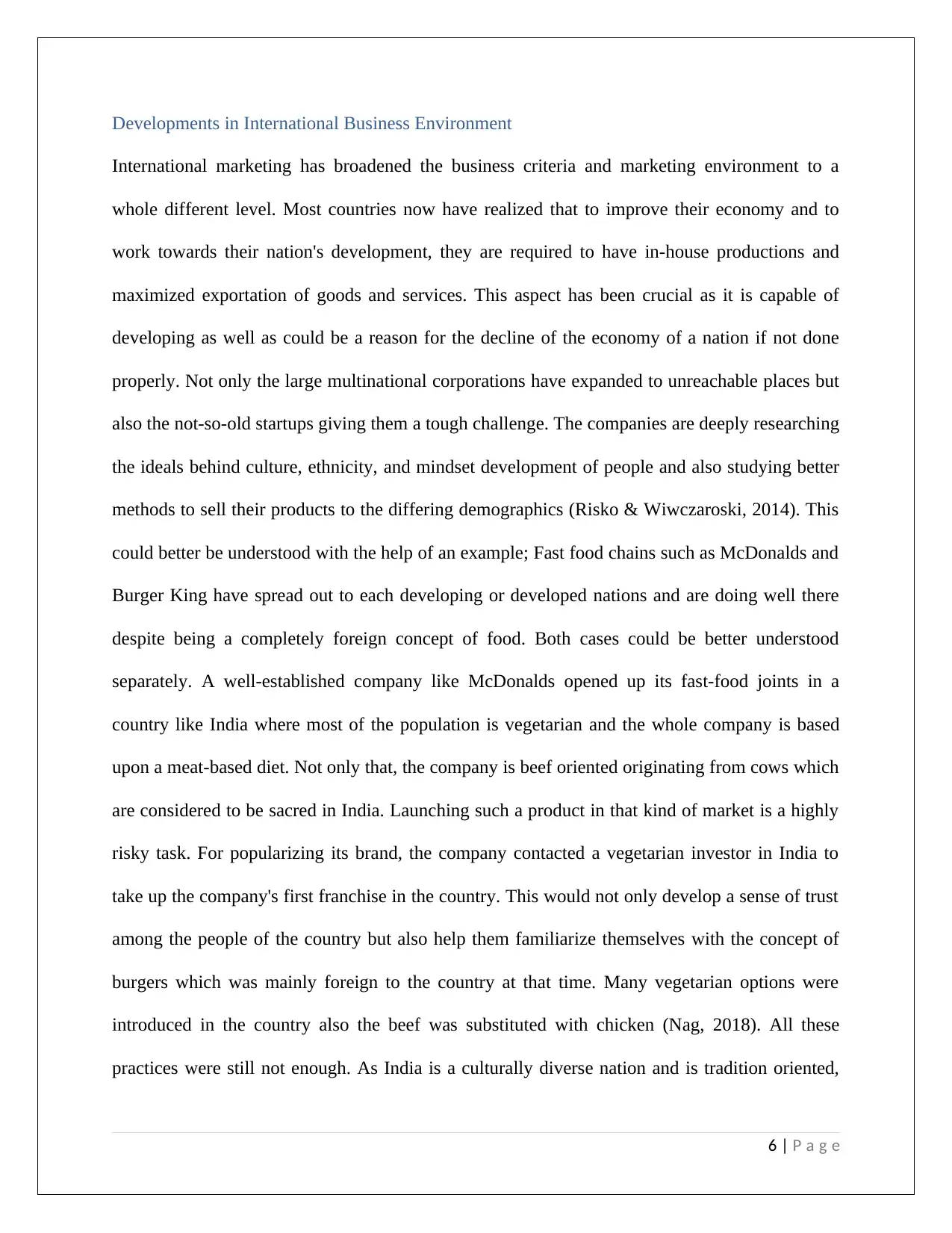
Developments in International Business Environment
International marketing has broadened the business criteria and marketing environment to a
whole different level. Most countries now have realized that to improve their economy and to
work towards their nation's development, they are required to have in-house productions and
maximized exportation of goods and services. This aspect has been crucial as it is capable of
developing as well as could be a reason for the decline of the economy of a nation if not done
properly. Not only the large multinational corporations have expanded to unreachable places but
also the not-so-old startups giving them a tough challenge. The companies are deeply researching
the ideals behind culture, ethnicity, and mindset development of people and also studying better
methods to sell their products to the differing demographics (Risko & Wiwczaroski, 2014). This
could better be understood with the help of an example; Fast food chains such as McDonalds and
Burger King have spread out to each developing or developed nations and are doing well there
despite being a completely foreign concept of food. Both cases could be better understood
separately. A well-established company like McDonalds opened up its fast-food joints in a
country like India where most of the population is vegetarian and the whole company is based
upon a meat-based diet. Not only that, the company is beef oriented originating from cows which
are considered to be sacred in India. Launching such a product in that kind of market is a highly
risky task. For popularizing its brand, the company contacted a vegetarian investor in India to
take up the company's first franchise in the country. This would not only develop a sense of trust
among the people of the country but also help them familiarize themselves with the concept of
burgers which was mainly foreign to the country at that time. Many vegetarian options were
introduced in the country also the beef was substituted with chicken (Nag, 2018). All these
practices were still not enough. As India is a culturally diverse nation and is tradition oriented,
6 | P a g e
International marketing has broadened the business criteria and marketing environment to a
whole different level. Most countries now have realized that to improve their economy and to
work towards their nation's development, they are required to have in-house productions and
maximized exportation of goods and services. This aspect has been crucial as it is capable of
developing as well as could be a reason for the decline of the economy of a nation if not done
properly. Not only the large multinational corporations have expanded to unreachable places but
also the not-so-old startups giving them a tough challenge. The companies are deeply researching
the ideals behind culture, ethnicity, and mindset development of people and also studying better
methods to sell their products to the differing demographics (Risko & Wiwczaroski, 2014). This
could better be understood with the help of an example; Fast food chains such as McDonalds and
Burger King have spread out to each developing or developed nations and are doing well there
despite being a completely foreign concept of food. Both cases could be better understood
separately. A well-established company like McDonalds opened up its fast-food joints in a
country like India where most of the population is vegetarian and the whole company is based
upon a meat-based diet. Not only that, the company is beef oriented originating from cows which
are considered to be sacred in India. Launching such a product in that kind of market is a highly
risky task. For popularizing its brand, the company contacted a vegetarian investor in India to
take up the company's first franchise in the country. This would not only develop a sense of trust
among the people of the country but also help them familiarize themselves with the concept of
burgers which was mainly foreign to the country at that time. Many vegetarian options were
introduced in the country also the beef was substituted with chicken (Nag, 2018). All these
practices were still not enough. As India is a culturally diverse nation and is tradition oriented,
6 | P a g e
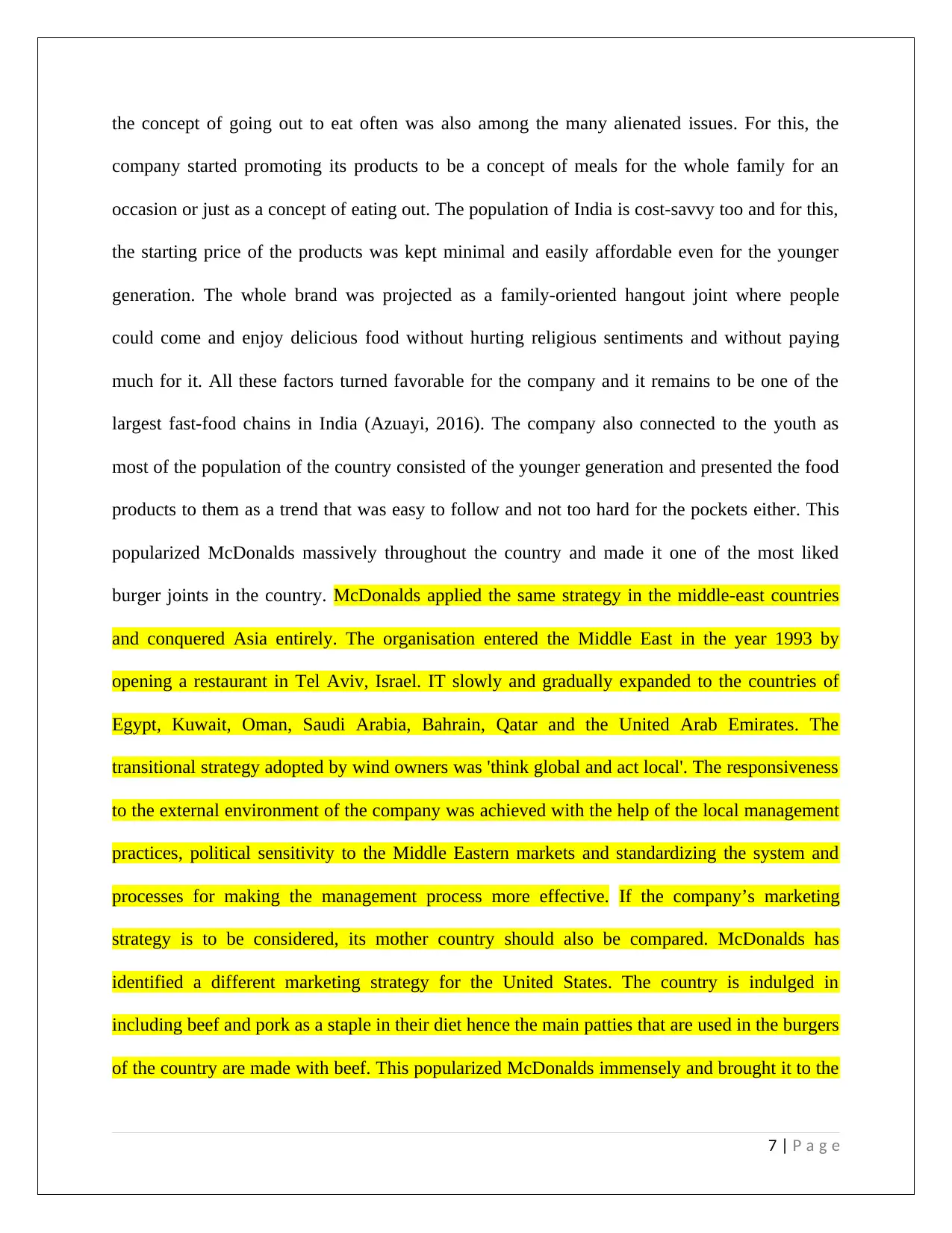
the concept of going out to eat often was also among the many alienated issues. For this, the
company started promoting its products to be a concept of meals for the whole family for an
occasion or just as a concept of eating out. The population of India is cost-savvy too and for this,
the starting price of the products was kept minimal and easily affordable even for the younger
generation. The whole brand was projected as a family-oriented hangout joint where people
could come and enjoy delicious food without hurting religious sentiments and without paying
much for it. All these factors turned favorable for the company and it remains to be one of the
largest fast-food chains in India (Azuayi, 2016). The company also connected to the youth as
most of the population of the country consisted of the younger generation and presented the food
products to them as a trend that was easy to follow and not too hard for the pockets either. This
popularized McDonalds massively throughout the country and made it one of the most liked
burger joints in the country. McDonalds applied the same strategy in the middle-east countries
and conquered Asia entirely. The organisation entered the Middle East in the year 1993 by
opening a restaurant in Tel Aviv, Israel. IT slowly and gradually expanded to the countries of
Egypt, Kuwait, Oman, Saudi Arabia, Bahrain, Qatar and the United Arab Emirates. The
transitional strategy adopted by wind owners was 'think global and act local'. The responsiveness
to the external environment of the company was achieved with the help of the local management
practices, political sensitivity to the Middle Eastern markets and standardizing the system and
processes for making the management process more effective. If the company’s marketing
strategy is to be considered, its mother country should also be compared. McDonalds has
identified a different marketing strategy for the United States. The country is indulged in
including beef and pork as a staple in their diet hence the main patties that are used in the burgers
of the country are made with beef. This popularized McDonalds immensely and brought it to the
7 | P a g e
company started promoting its products to be a concept of meals for the whole family for an
occasion or just as a concept of eating out. The population of India is cost-savvy too and for this,
the starting price of the products was kept minimal and easily affordable even for the younger
generation. The whole brand was projected as a family-oriented hangout joint where people
could come and enjoy delicious food without hurting religious sentiments and without paying
much for it. All these factors turned favorable for the company and it remains to be one of the
largest fast-food chains in India (Azuayi, 2016). The company also connected to the youth as
most of the population of the country consisted of the younger generation and presented the food
products to them as a trend that was easy to follow and not too hard for the pockets either. This
popularized McDonalds massively throughout the country and made it one of the most liked
burger joints in the country. McDonalds applied the same strategy in the middle-east countries
and conquered Asia entirely. The organisation entered the Middle East in the year 1993 by
opening a restaurant in Tel Aviv, Israel. IT slowly and gradually expanded to the countries of
Egypt, Kuwait, Oman, Saudi Arabia, Bahrain, Qatar and the United Arab Emirates. The
transitional strategy adopted by wind owners was 'think global and act local'. The responsiveness
to the external environment of the company was achieved with the help of the local management
practices, political sensitivity to the Middle Eastern markets and standardizing the system and
processes for making the management process more effective. If the company’s marketing
strategy is to be considered, its mother country should also be compared. McDonalds has
identified a different marketing strategy for the United States. The country is indulged in
including beef and pork as a staple in their diet hence the main patties that are used in the burgers
of the country are made with beef. This popularized McDonalds immensely and brought it to the
7 | P a g e
Paraphrase This Document
Need a fresh take? Get an instant paraphrase of this document with our AI Paraphraser
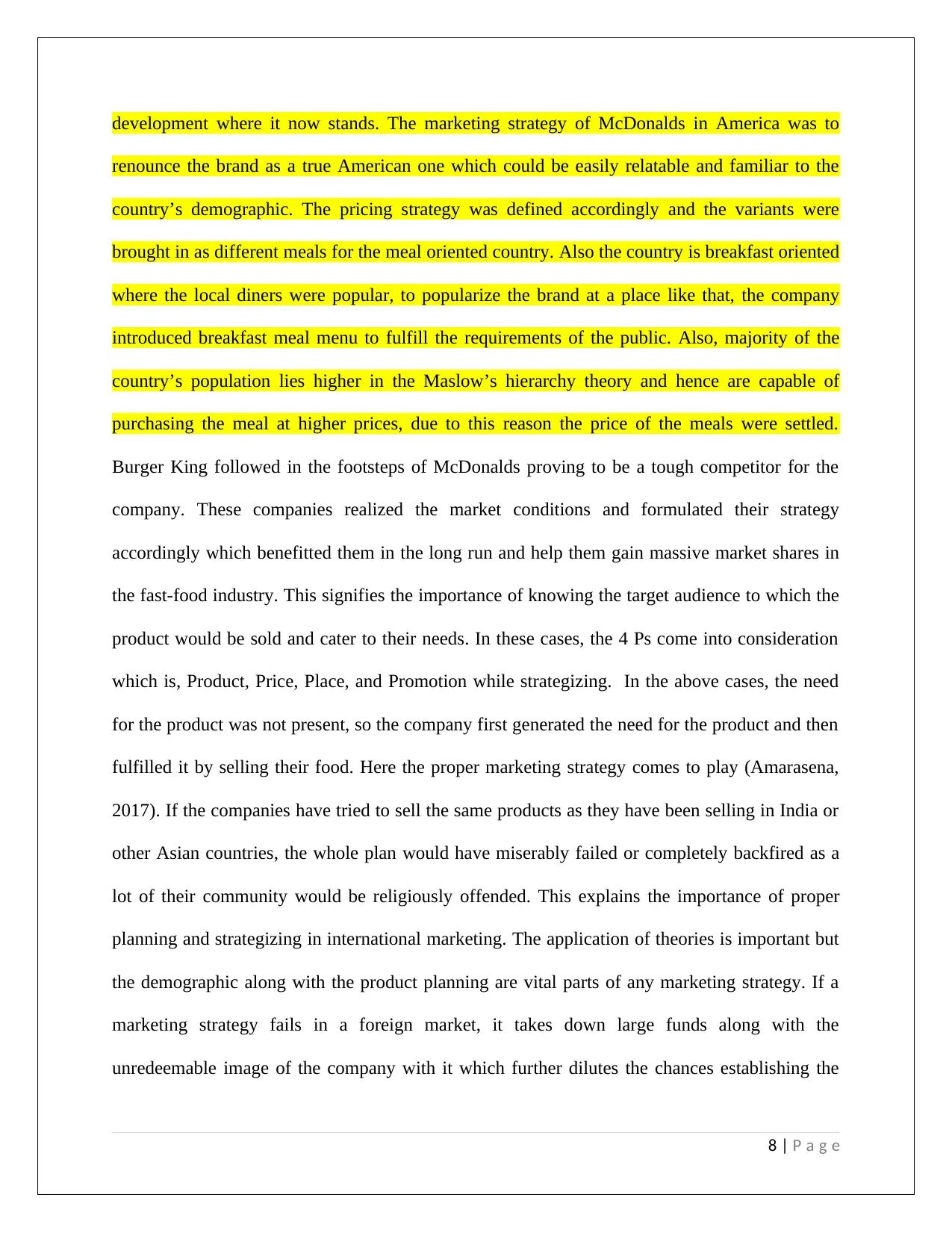
development where it now stands. The marketing strategy of McDonalds in America was to
renounce the brand as a true American one which could be easily relatable and familiar to the
country’s demographic. The pricing strategy was defined accordingly and the variants were
brought in as different meals for the meal oriented country. Also the country is breakfast oriented
where the local diners were popular, to popularize the brand at a place like that, the company
introduced breakfast meal menu to fulfill the requirements of the public. Also, majority of the
country’s population lies higher in the Maslow’s hierarchy theory and hence are capable of
purchasing the meal at higher prices, due to this reason the price of the meals were settled.
Burger King followed in the footsteps of McDonalds proving to be a tough competitor for the
company. These companies realized the market conditions and formulated their strategy
accordingly which benefitted them in the long run and help them gain massive market shares in
the fast-food industry. This signifies the importance of knowing the target audience to which the
product would be sold and cater to their needs. In these cases, the 4 Ps come into consideration
which is, Product, Price, Place, and Promotion while strategizing. In the above cases, the need
for the product was not present, so the company first generated the need for the product and then
fulfilled it by selling their food. Here the proper marketing strategy comes to play (Amarasena,
2017). If the companies have tried to sell the same products as they have been selling in India or
other Asian countries, the whole plan would have miserably failed or completely backfired as a
lot of their community would be religiously offended. This explains the importance of proper
planning and strategizing in international marketing. The application of theories is important but
the demographic along with the product planning are vital parts of any marketing strategy. If a
marketing strategy fails in a foreign market, it takes down large funds along with the
unredeemable image of the company with it which further dilutes the chances establishing the
8 | P a g e
renounce the brand as a true American one which could be easily relatable and familiar to the
country’s demographic. The pricing strategy was defined accordingly and the variants were
brought in as different meals for the meal oriented country. Also the country is breakfast oriented
where the local diners were popular, to popularize the brand at a place like that, the company
introduced breakfast meal menu to fulfill the requirements of the public. Also, majority of the
country’s population lies higher in the Maslow’s hierarchy theory and hence are capable of
purchasing the meal at higher prices, due to this reason the price of the meals were settled.
Burger King followed in the footsteps of McDonalds proving to be a tough competitor for the
company. These companies realized the market conditions and formulated their strategy
accordingly which benefitted them in the long run and help them gain massive market shares in
the fast-food industry. This signifies the importance of knowing the target audience to which the
product would be sold and cater to their needs. In these cases, the 4 Ps come into consideration
which is, Product, Price, Place, and Promotion while strategizing. In the above cases, the need
for the product was not present, so the company first generated the need for the product and then
fulfilled it by selling their food. Here the proper marketing strategy comes to play (Amarasena,
2017). If the companies have tried to sell the same products as they have been selling in India or
other Asian countries, the whole plan would have miserably failed or completely backfired as a
lot of their community would be religiously offended. This explains the importance of proper
planning and strategizing in international marketing. The application of theories is important but
the demographic along with the product planning are vital parts of any marketing strategy. If a
marketing strategy fails in a foreign market, it takes down large funds along with the
unredeemable image of the company with it which further dilutes the chances establishing the
8 | P a g e
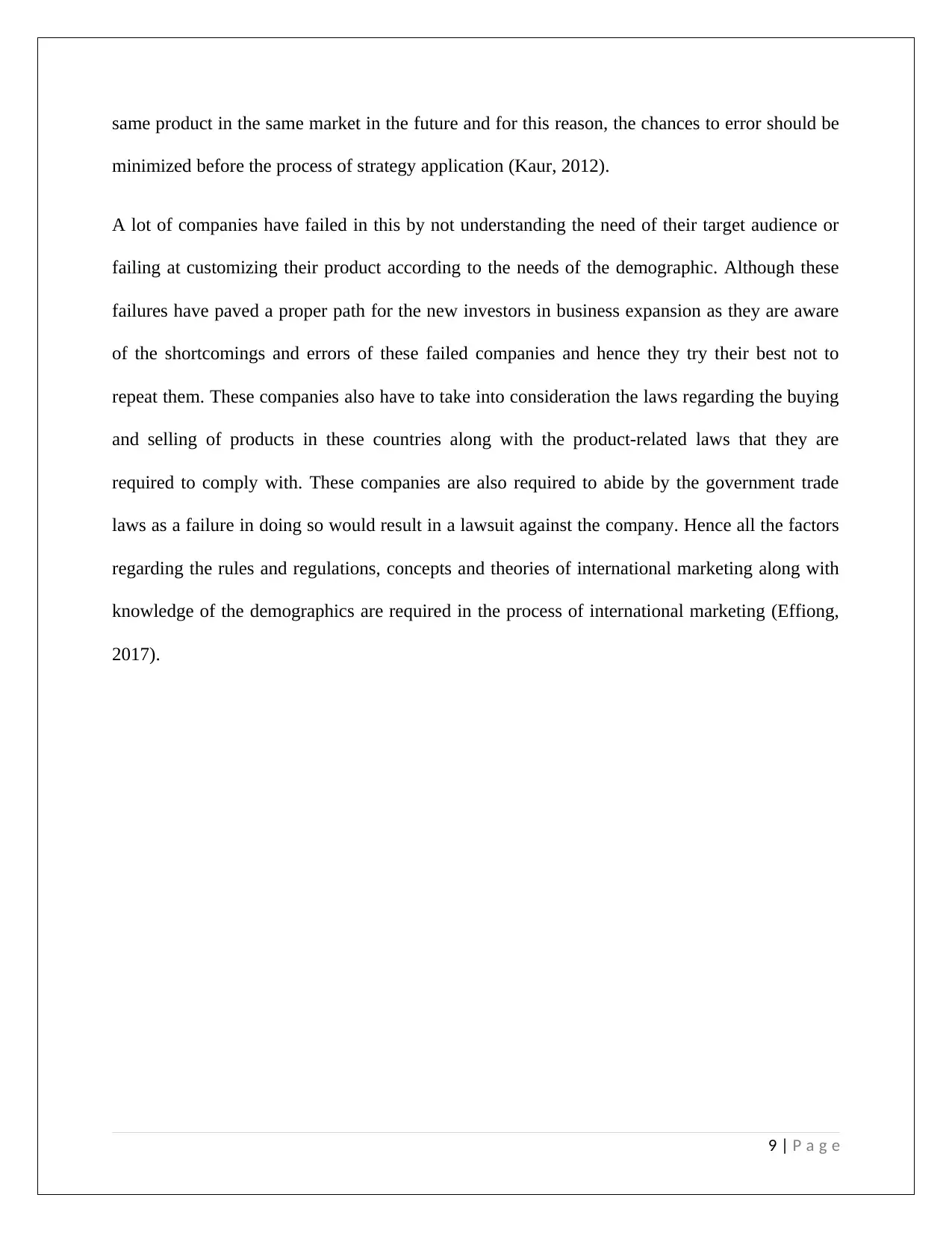
same product in the same market in the future and for this reason, the chances to error should be
minimized before the process of strategy application (Kaur, 2012).
A lot of companies have failed in this by not understanding the need of their target audience or
failing at customizing their product according to the needs of the demographic. Although these
failures have paved a proper path for the new investors in business expansion as they are aware
of the shortcomings and errors of these failed companies and hence they try their best not to
repeat them. These companies also have to take into consideration the laws regarding the buying
and selling of products in these countries along with the product-related laws that they are
required to comply with. These companies are also required to abide by the government trade
laws as a failure in doing so would result in a lawsuit against the company. Hence all the factors
regarding the rules and regulations, concepts and theories of international marketing along with
knowledge of the demographics are required in the process of international marketing (Effiong,
2017).
9 | P a g e
minimized before the process of strategy application (Kaur, 2012).
A lot of companies have failed in this by not understanding the need of their target audience or
failing at customizing their product according to the needs of the demographic. Although these
failures have paved a proper path for the new investors in business expansion as they are aware
of the shortcomings and errors of these failed companies and hence they try their best not to
repeat them. These companies also have to take into consideration the laws regarding the buying
and selling of products in these countries along with the product-related laws that they are
required to comply with. These companies are also required to abide by the government trade
laws as a failure in doing so would result in a lawsuit against the company. Hence all the factors
regarding the rules and regulations, concepts and theories of international marketing along with
knowledge of the demographics are required in the process of international marketing (Effiong,
2017).
9 | P a g e
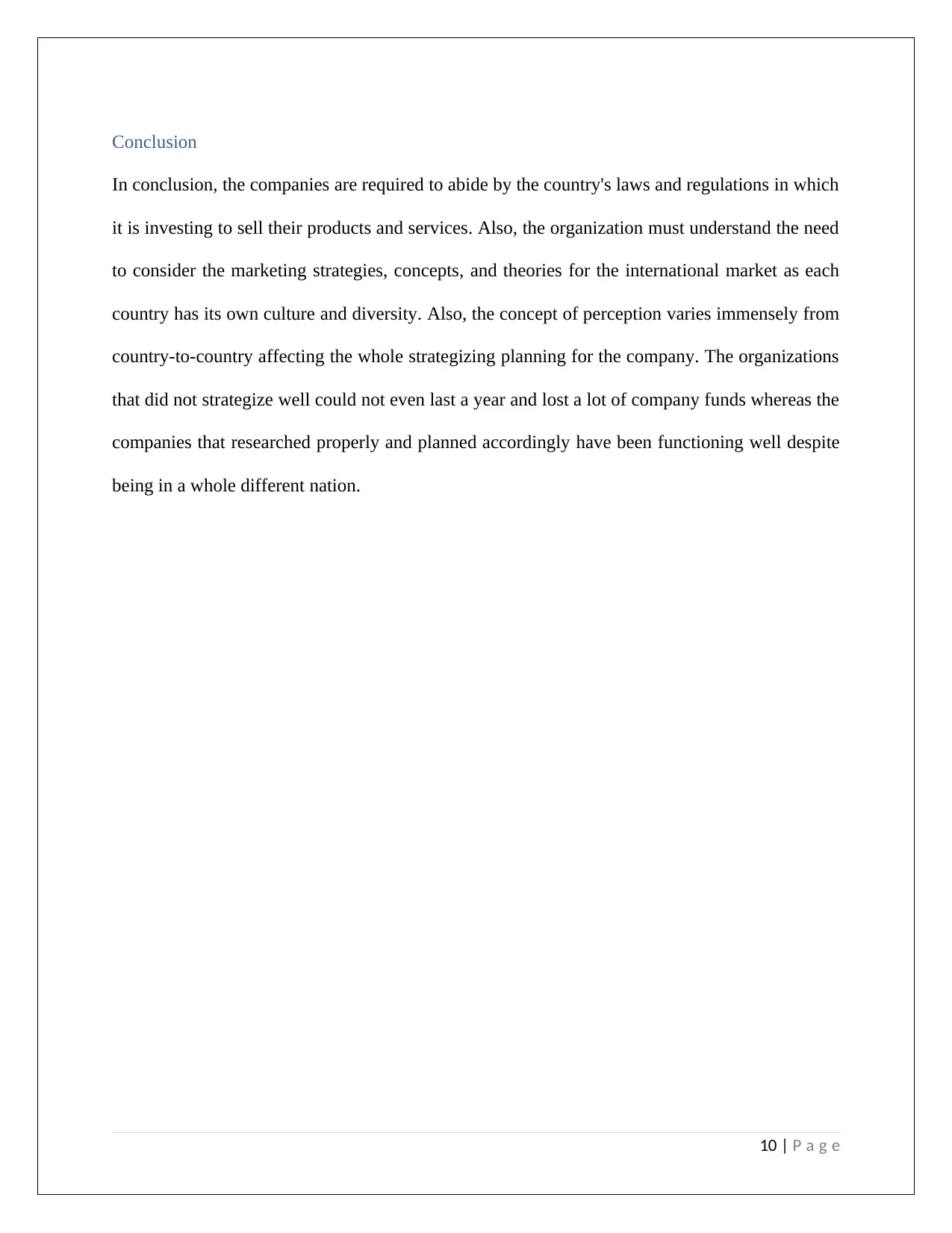
Conclusion
In conclusion, the companies are required to abide by the country's laws and regulations in which
it is investing to sell their products and services. Also, the organization must understand the need
to consider the marketing strategies, concepts, and theories for the international market as each
country has its own culture and diversity. Also, the concept of perception varies immensely from
country-to-country affecting the whole strategizing planning for the company. The organizations
that did not strategize well could not even last a year and lost a lot of company funds whereas the
companies that researched properly and planned accordingly have been functioning well despite
being in a whole different nation.
10 | P a g e
In conclusion, the companies are required to abide by the country's laws and regulations in which
it is investing to sell their products and services. Also, the organization must understand the need
to consider the marketing strategies, concepts, and theories for the international market as each
country has its own culture and diversity. Also, the concept of perception varies immensely from
country-to-country affecting the whole strategizing planning for the company. The organizations
that did not strategize well could not even last a year and lost a lot of company funds whereas the
companies that researched properly and planned accordingly have been functioning well despite
being in a whole different nation.
10 | P a g e
Secure Best Marks with AI Grader
Need help grading? Try our AI Grader for instant feedback on your assignments.
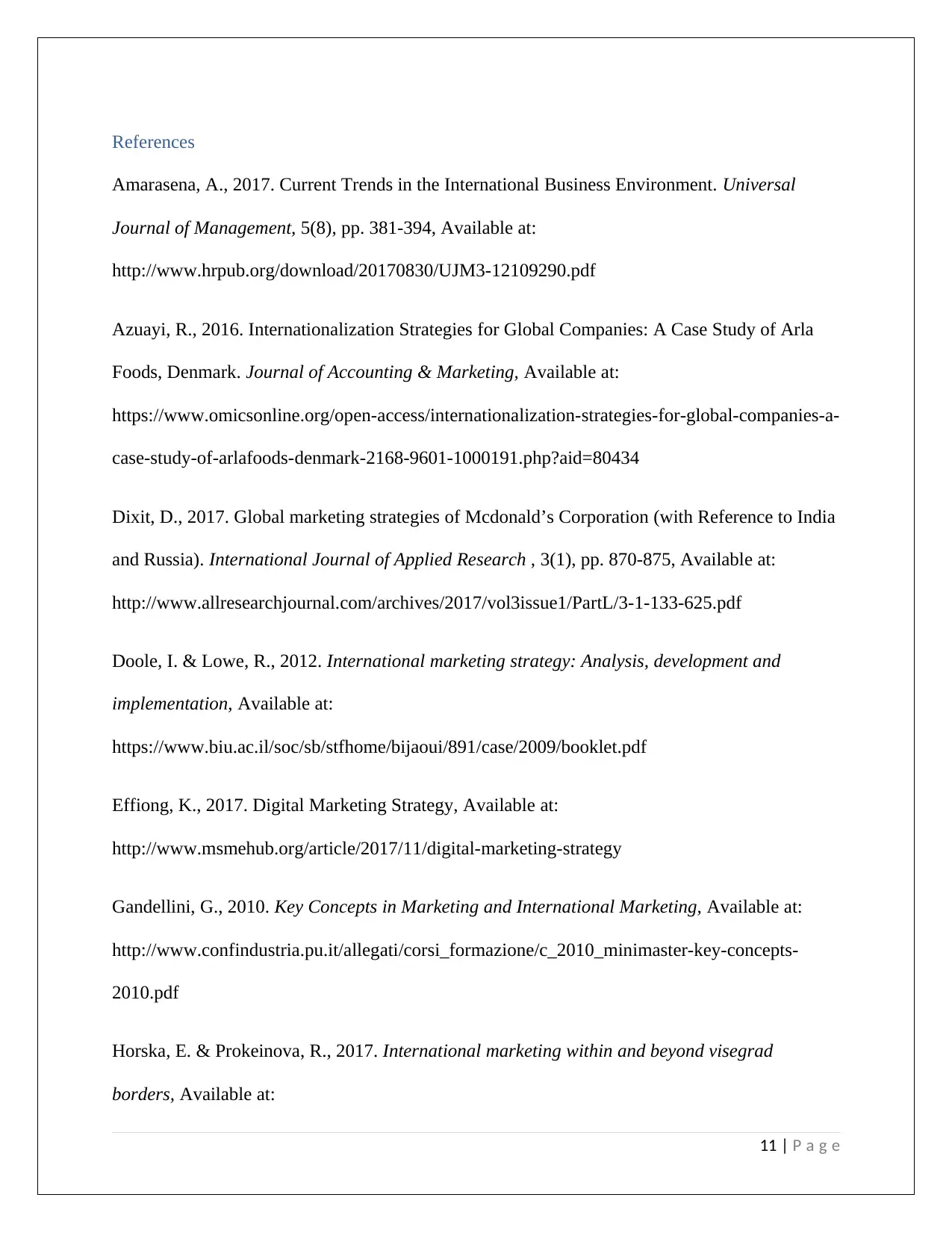
References
Amarasena, A., 2017. Current Trends in the International Business Environment. Universal
Journal of Management, 5(8), pp. 381-394, Available at:
http://www.hrpub.org/download/20170830/UJM3-12109290.pdf
Azuayi, R., 2016. Internationalization Strategies for Global Companies: A Case Study of Arla
Foods, Denmark. Journal of Accounting & Marketing, Available at:
https://www.omicsonline.org/open-access/internationalization-strategies-for-global-companies-a-
case-study-of-arlafoods-denmark-2168-9601-1000191.php?aid=80434
Dixit, D., 2017. Global marketing strategies of Mcdonald’s Corporation (with Reference to India
and Russia). International Journal of Applied Research , 3(1), pp. 870-875, Available at:
http://www.allresearchjournal.com/archives/2017/vol3issue1/PartL/3-1-133-625.pdf
Doole, I. & Lowe, R., 2012. International marketing strategy: Analysis, development and
implementation, Available at:
https://www.biu.ac.il/soc/sb/stfhome/bijaoui/891/case/2009/booklet.pdf
Effiong, K., 2017. Digital Marketing Strategy, Available at:
http://www.msmehub.org/article/2017/11/digital-marketing-strategy
Gandellini, G., 2010. Key Concepts in Marketing and International Marketing, Available at:
http://www.confindustria.pu.it/allegati/corsi_formazione/c_2010_minimaster-key-concepts-
2010.pdf
Horska, E. & Prokeinova, R., 2017. International marketing within and beyond visegrad
borders, Available at:
11 | P a g e
Amarasena, A., 2017. Current Trends in the International Business Environment. Universal
Journal of Management, 5(8), pp. 381-394, Available at:
http://www.hrpub.org/download/20170830/UJM3-12109290.pdf
Azuayi, R., 2016. Internationalization Strategies for Global Companies: A Case Study of Arla
Foods, Denmark. Journal of Accounting & Marketing, Available at:
https://www.omicsonline.org/open-access/internationalization-strategies-for-global-companies-a-
case-study-of-arlafoods-denmark-2168-9601-1000191.php?aid=80434
Dixit, D., 2017. Global marketing strategies of Mcdonald’s Corporation (with Reference to India
and Russia). International Journal of Applied Research , 3(1), pp. 870-875, Available at:
http://www.allresearchjournal.com/archives/2017/vol3issue1/PartL/3-1-133-625.pdf
Doole, I. & Lowe, R., 2012. International marketing strategy: Analysis, development and
implementation, Available at:
https://www.biu.ac.il/soc/sb/stfhome/bijaoui/891/case/2009/booklet.pdf
Effiong, K., 2017. Digital Marketing Strategy, Available at:
http://www.msmehub.org/article/2017/11/digital-marketing-strategy
Gandellini, G., 2010. Key Concepts in Marketing and International Marketing, Available at:
http://www.confindustria.pu.it/allegati/corsi_formazione/c_2010_minimaster-key-concepts-
2010.pdf
Horska, E. & Prokeinova, R., 2017. International marketing within and beyond visegrad
borders, Available at:
11 | P a g e
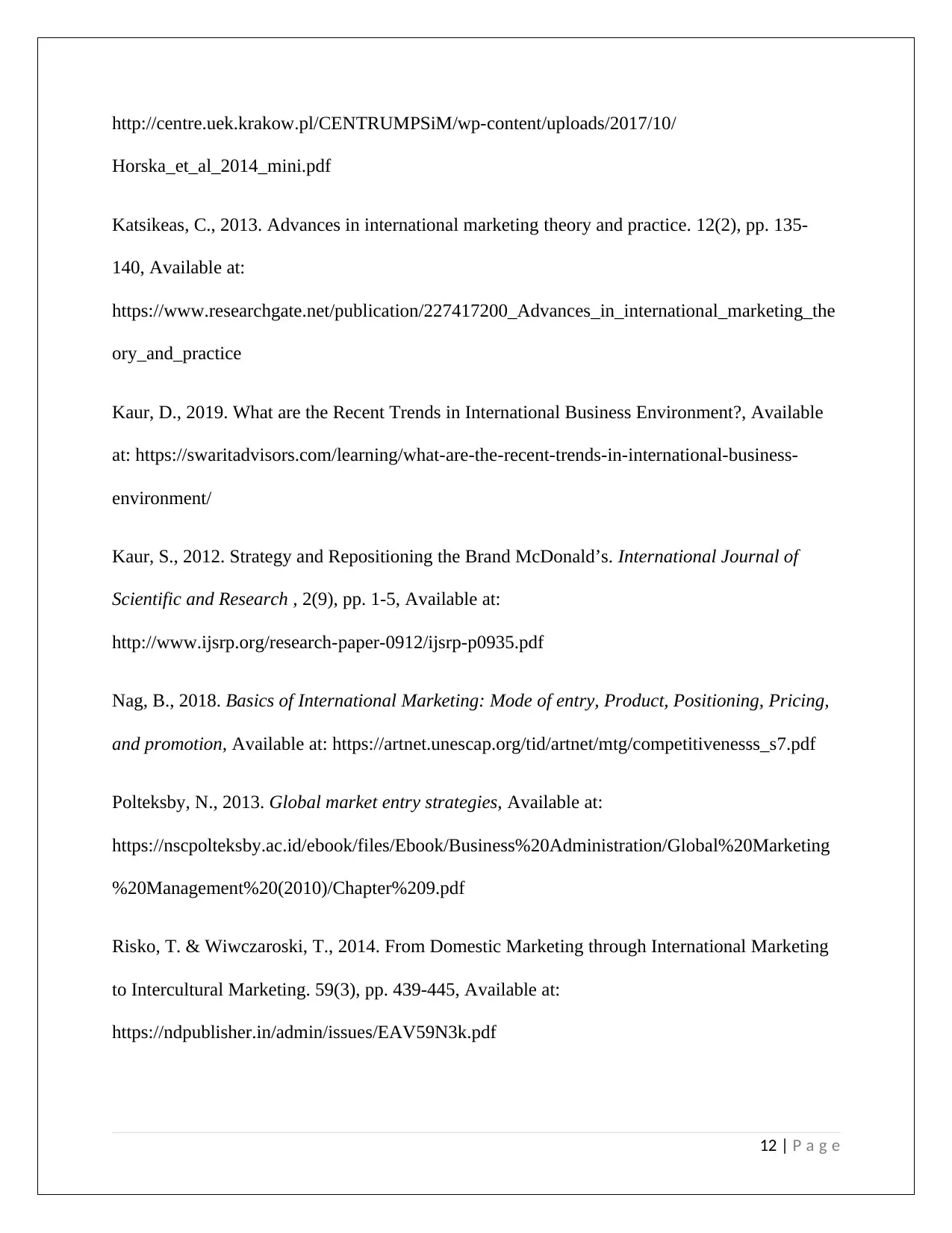
http://centre.uek.krakow.pl/CENTRUMPSiM/wp-content/uploads/2017/10/
Horska_et_al_2014_mini.pdf
Katsikeas, C., 2013. Advances in international marketing theory and practice. 12(2), pp. 135-
140, Available at:
https://www.researchgate.net/publication/227417200_Advances_in_international_marketing_the
ory_and_practice
Kaur, D., 2019. What are the Recent Trends in International Business Environment?, Available
at: https://swaritadvisors.com/learning/what-are-the-recent-trends-in-international-business-
environment/
Kaur, S., 2012. Strategy and Repositioning the Brand McDonald’s. International Journal of
Scientific and Research , 2(9), pp. 1-5, Available at:
http://www.ijsrp.org/research-paper-0912/ijsrp-p0935.pdf
Nag, B., 2018. Basics of International Marketing: Mode of entry, Product, Positioning, Pricing,
and promotion, Available at: https://artnet.unescap.org/tid/artnet/mtg/competitivenesss_s7.pdf
Polteksby, N., 2013. Global market entry strategies, Available at:
https://nscpolteksby.ac.id/ebook/files/Ebook/Business%20Administration/Global%20Marketing
%20Management%20(2010)/Chapter%209.pdf
Risko, T. & Wiwczaroski, T., 2014. From Domestic Marketing through International Marketing
to Intercultural Marketing. 59(3), pp. 439-445, Available at:
https://ndpublisher.in/admin/issues/EAV59N3k.pdf
12 | P a g e
Horska_et_al_2014_mini.pdf
Katsikeas, C., 2013. Advances in international marketing theory and practice. 12(2), pp. 135-
140, Available at:
https://www.researchgate.net/publication/227417200_Advances_in_international_marketing_the
ory_and_practice
Kaur, D., 2019. What are the Recent Trends in International Business Environment?, Available
at: https://swaritadvisors.com/learning/what-are-the-recent-trends-in-international-business-
environment/
Kaur, S., 2012. Strategy and Repositioning the Brand McDonald’s. International Journal of
Scientific and Research , 2(9), pp. 1-5, Available at:
http://www.ijsrp.org/research-paper-0912/ijsrp-p0935.pdf
Nag, B., 2018. Basics of International Marketing: Mode of entry, Product, Positioning, Pricing,
and promotion, Available at: https://artnet.unescap.org/tid/artnet/mtg/competitivenesss_s7.pdf
Polteksby, N., 2013. Global market entry strategies, Available at:
https://nscpolteksby.ac.id/ebook/files/Ebook/Business%20Administration/Global%20Marketing
%20Management%20(2010)/Chapter%209.pdf
Risko, T. & Wiwczaroski, T., 2014. From Domestic Marketing through International Marketing
to Intercultural Marketing. 59(3), pp. 439-445, Available at:
https://ndpublisher.in/admin/issues/EAV59N3k.pdf
12 | P a g e
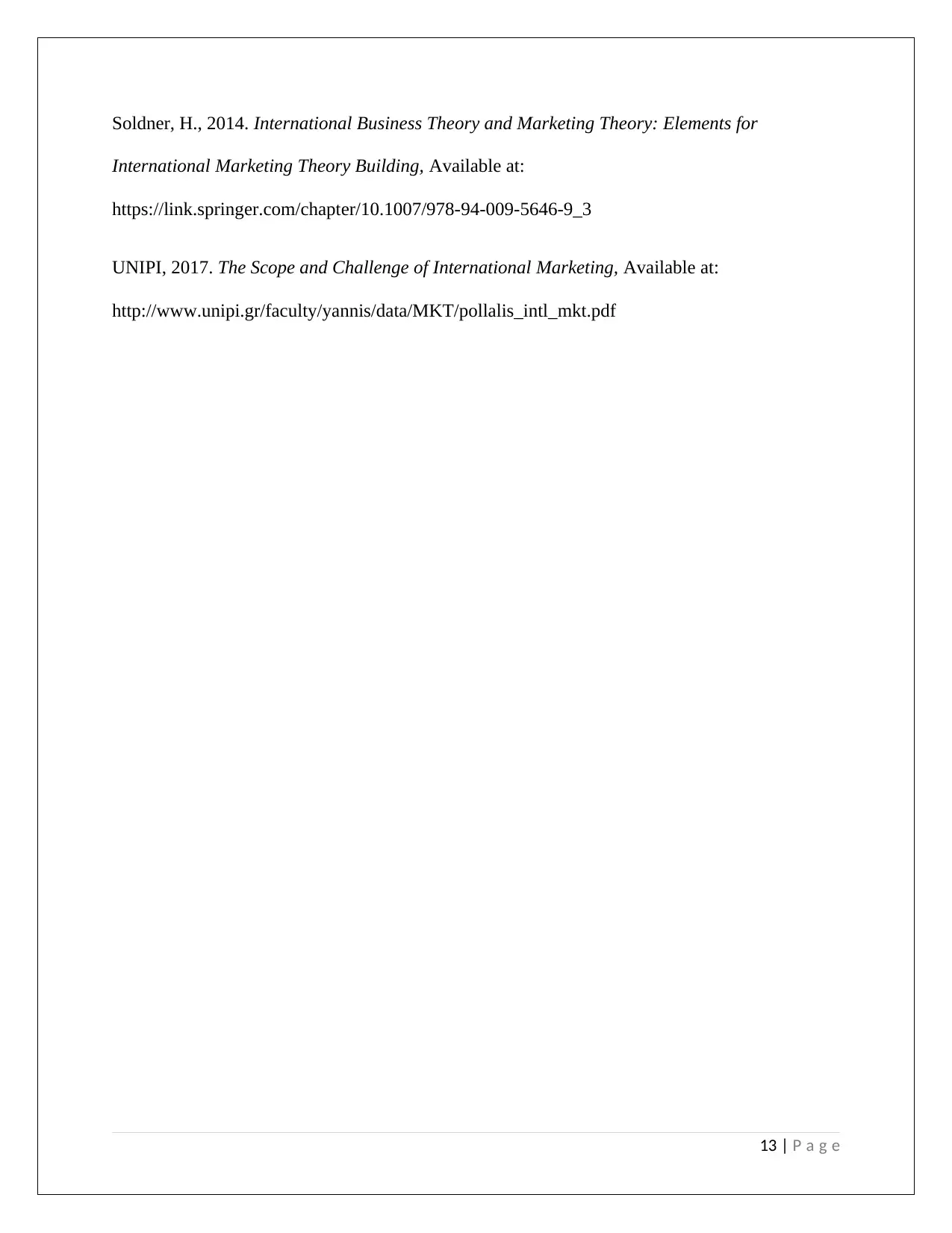
Soldner, H., 2014. International Business Theory and Marketing Theory: Elements for
International Marketing Theory Building, Available at:
https://link.springer.com/chapter/10.1007/978-94-009-5646-9_3
UNIPI, 2017. The Scope and Challenge of International Marketing, Available at:
http://www.unipi.gr/faculty/yannis/data/MKT/pollalis_intl_mkt.pdf
13 | P a g e
International Marketing Theory Building, Available at:
https://link.springer.com/chapter/10.1007/978-94-009-5646-9_3
UNIPI, 2017. The Scope and Challenge of International Marketing, Available at:
http://www.unipi.gr/faculty/yannis/data/MKT/pollalis_intl_mkt.pdf
13 | P a g e
1 out of 13
Related Documents
Your All-in-One AI-Powered Toolkit for Academic Success.
+13062052269
info@desklib.com
Available 24*7 on WhatsApp / Email
![[object Object]](/_next/static/media/star-bottom.7253800d.svg)
Unlock your academic potential
© 2024 | Zucol Services PVT LTD | All rights reserved.




